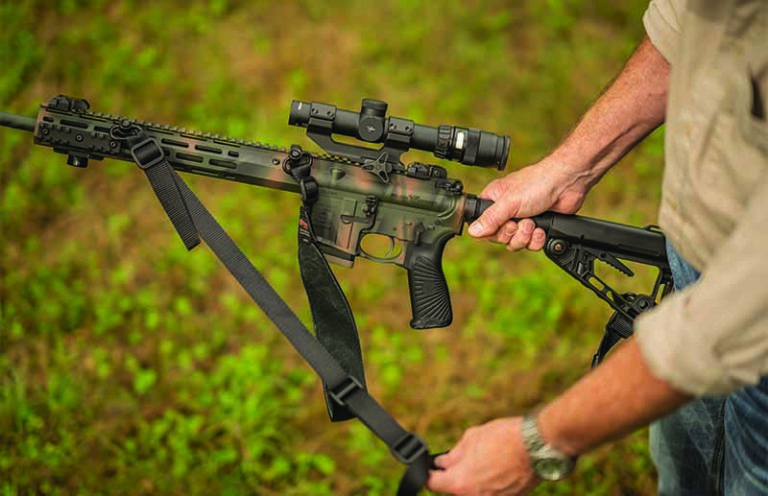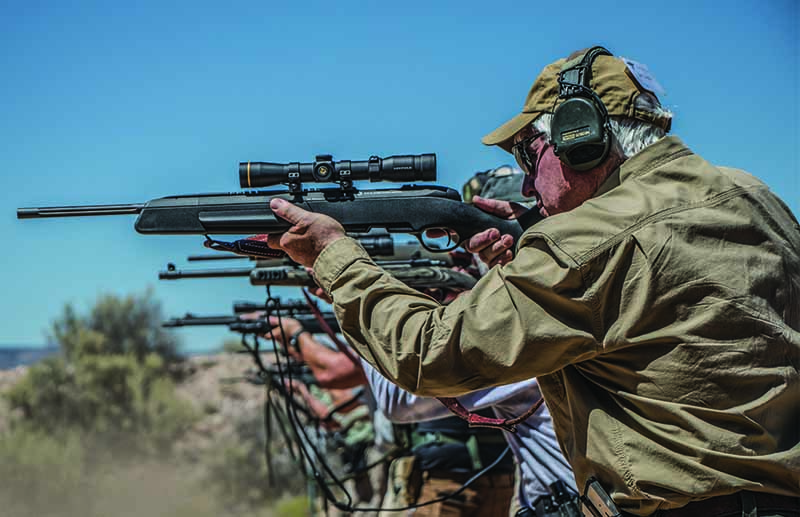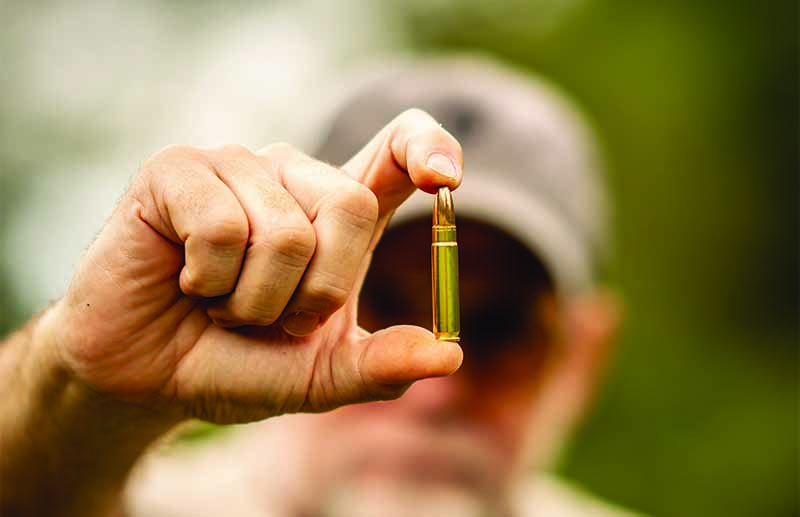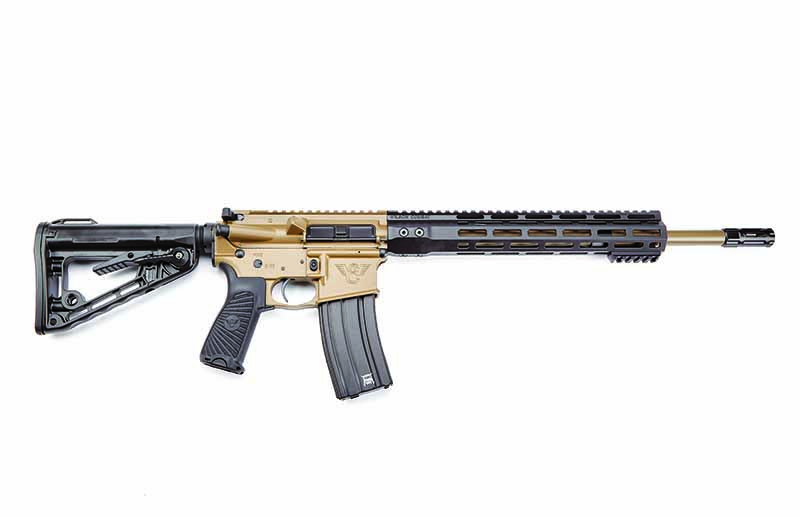
The best general-purpose rifle—a rifle well adapted to just about any task—is in fact somewhat ironically, a very specialized weapon.
What Are The Traits Of A General-Purpose Rifle:
- Compact
- Light
- Power and reach
- Accurate
- High volume of fire
- Chambered for a cartridge easily reloaded
At one time, the .50-caliber Hawken was America’s general-purpose rifle. About 70 years later, it was replaced by the Winchester 94 in .30-30 Winchester, and after World War I, the bolt-action .30-06 became America’s one-rifle answer. It remained so until the turn of the 21st century. At that time, the AR-15—or modern sporting rifle (MSR) as it’s known among the politically correct—and the easy recoiling .223 Remington stole that title away.

Modern advancements in weaponry, ammunition and optical sights were partly responsible for these transitions. Interestingly, we passed from a single-shot, to a lever-action, to a bolt-action and to a semi-automatic. We also went from a rifle delivering about 500 ft-lb of energy at 100 yards to one with 1,400 (.30-30 Winchester), to 2,000 (.30-06 Springfield) and 900 (.223 Remington) fpe. But, in addition to technology, specialization played a large part in the evolution America’s general-purpose rifle has gone through.
With the increase in wild game populations after World War II and, with an elevated interest in sport shooting, Americans began to acquire specialized rifles designed to solve specific problems. A man might have a .22-250 for groundhog or prairie dog shooting, a .243 for whitetails or pronghorn, and a big seven or .300 magnum for elk, moose and even deer. The one-man, one-rifle concept was vanishing.
The Cooper Concept
About this time, Jeff Cooper, a Marine and founder of what’s now known as Gunsite Academy, conceived the Scout Rifle concept. It was offered as a return to the one-man, one-rifle notion and was in stark contrast to specialization. Cooper theorized in the best general-purpose rifle—a rifle well adapted to just about any task—was in fact somewhat ironically, a very specialized weapon. Among other things, he stipulated a .308 Winchester with a maximum length of one meter, a maximum weight of between 6.6 to 7.7 pounds, backup sights and forward-mounted low-power riflescope, capable of launching a 150-grain bullet at 2,700 fps. Ironically, this was the same external ballistics of the original .30-06 loading.

As the 20th century faded, sport shooting became very popular, and the latest combat veterans had established a relationship with the AR platform. It’s newfound modularity—and the ability to build your own—rocketed it to stardom. Many still had an arsenal of specialized hunting and sport rifles, but the behind the door—hell in a handbasket—rifle had become the AR-15.
Cooper’s concept developed a cult-like following but never achieved universal acceptance. His ultimate goal was for a mass-produced rifle with worldwide appeal and compatibility. The Scout Rifle, as conceived by Cooper, was never intended to address specialized needs based on geography or the individual; it was to be a one-rifle answer for the world.
And, while it very might well be that, the American citizen’s ability to own many rifles, specialized to solve particular problems, detracted from the Scout Rifle’s appeal. Unless it’s an SUV or a Leatherman, most Americans want specific tools, specifically designed, for specific problems.
I have a safe full of specialized rifles, but Cooper’s enigma of the Scout Rifle had tremendous appeal and I began a deep dive into its suitability as a one-rifle answer. I’ve fired more than 10,000 rounds through Scout Rifles, used them to hunt across America and Africa, founded the annual Scout Rifle Safari, devised a Scout Rifle training program for Steyr, and even wrote a book about all that I had learned. I like Scout Rifles, own many, and find the concept a practical answer to the general-purpose rifle question. However, a Scout Rifle, as defined by Cooper, is not my general-purpose rifle.
Defining “General Purpose”
Before describing my general-purpose rifle, let’s examine what a “general-purpose rifle” really is. Cooper thought it a worldly gun—one to be used to sort problems anywhere around the globe. That’s a noble desire, but from a real-world standpoint, one few need or even want. Most Americans spend 99 percent of their time very close to home and want a rifle best suited to deal with the problems they might most likely encounter. For most, global appeal means nothing.

My best friend lives on Kodiak Island and had to kill a big bear that was threatening. A general-purpose rifle for him must be capable of solving that problem. I live in the forested mountains of West Virginia where the most dangerous critter I’m likely to encounter is a rabid fox, raccoon or human being with murderous intent. Our largest game animals are deer and black bear. Other hillbillies and I don’t need a grizzly gun.
Build Your Rifle IQ:- Best Budget AR-15 Options And Buyers Guide
- 5 Best Scout Rifles To Seriously Consider For Survival
- Top 17 Affordable Precision Rifles — Bolt-Action Edition
- Bolt-Action Vs Semi-Auto Rifle For Precision Shooting
- Bolt-Action Rifles: Push Feed Vs. Controlled Feed
The point is, the general-purpose needs of every man are different and dependent on the conditions of their life and location. Some years back, I suggested a one-rifle answer for most folks would be a CUR (Conditional Utility Rifle) as opposed to a Scout Rifle. Much like cur dogs bred for specific geographical needs, like the Rhodesian Ridgeback of Africa, the Rattlesnake Cur of the Appalachians, or Catahoula Leopard Dogs of Louisiana, CUR rifles are general-purpose rifles ideally adapted to fill the specific needs of their owners as opposed to the everyone. Though these rifles share many attributes of a Scout Rifle, such as compactness, lightness and redundant sight systems, they differ due to geographic, social and political—specialized—needs.
My background is steeped in hunting, but I also spent much of my professional life in uniform—camouflaged and blue—carrying guns in defense of country and community. I also have a respectable firearms training résumé. This isn’t meant to brag, just to illustrate that I’m not just a hillbilly who’s never gotten off the farm. When I decided I wanted a general-purpose rifle best suited to my needs, I set forth the following parameters:
- Compactness: I wanted a rifle that was easy to transport in a vehicle or use from inside a blind or hide, with a maximum length of less than 36 inches.
- Lightness: Rifles are carried more than shot. I wanted a rifle weighing 6.5 pounds or less before accessories.
- Power and Reach: I needed a rifle with sufficient power to deal with human adversaries, black bear and deer out to around 300 yards.
- Accuracy: I planned to use the rifle to for a wide range of tasks and desired 1 MOA or better precision.
- Volume Fire: To fill my predator calling, sport shooting and self-defense needs, I wanted a semi-automatic.
- Modularity: I wanted a rifle very adaptable to specialized tasks.
- Self-Support: The rifle needed to be chambered for a cartridge for which I could create my own ammunition. I’m not a doomsday kind of guy, but ammo shortages are real.

In the end, the choice made itself. The requirements of volume fire, modularity, compactness and lightness, pushed me toward the AR-15 platform. My stipulation for power and reach required the .300 Hamr cartridge. Since .30-caliber bullets are easy to find, and since brass for the .300 Hamr can be made from .223 Remington, it also filled the self-support requirement. And finally, the demand for a high level of precision meant I needed one of high-quality manufacture. The fact that AR-15 gun parts are readily available played no small part in the decision.
The One And Only
What I ended up with was a Wilson Combat Protector Series Carbine ($1,999.95) with a 16-inch barrel. I installed what I consider one of the best general-purpose optical sights for use out to about 300 yards, a Trijicon 1-4X AccuPoint ($1,099) in a Wilson Combat one-piece mount. The 1X magnification can sort out close-quarter engagements and snap shots, and 4X takes me to the limits of the cartridge.
For backup sights, I went with the Williams Gun Sight Company Tactical Folding Sight Set ($139.95,) which are very well-made fold-down sights that attach directly to the rifle’s full-length top rail. I also took a Galco Rifleman Sling ($59) and configured it for three-point attachment.

Now, I’m not fond of screwing needless weight to my rifle, but I do appreciate a rifle allowing situational adaptation. The threaded muzzle permits the use of the fantastically light 11-ounce Sig Sauer SLX suppressor ($1,200). A Spartan Precision Equipment bipod/tripod receptor ($56.80) was attached to the underside of the M-Lok compatible handguard, and a short rail section was added to allow for the attachment of a SureFire M600DF 1,500-lumen Scout Weapon Light ($299).
The rifle, as cool and well suited to my needs as it is, is nothing without ammunition. Wilson Combat offers a dozen or so loads for the .300 Hamr, and while I use several, my default general-purpose load is the .130-grain HHC (Hamr Hot Core) load ($25.95/20 or $247/200) at about 2,500 fps. This load uses a special bullet designed for the .300 Hamr by Speer. In 10 percent ordnance gelatin, you can expect more than 16 inches of penetration and double diameter expansion. It’ll even remain terminally effective after penetrating two layers of 14-gauge steel or multiple layers of plywood and drywall.
Here, too, is another consideration. With this rifle’s compactness, moderate weight and minimal recoil, it’s easily handled by my wife and both of my teenage daughters. This is an aspect of “general purpose” that’s often overlooked. If you’re the only person in your household who can effectively wield your general-purpose rifle, then it actually becomes a rifle of limited or specialized application.
I’ll not be so bold as to claim Cooper’s Scout Rifle concept as something without merit. I have several Scout Rifles I routinely use and will always have one close. What I’ll say and stand behind is that while a true Scout Rifle might be of wondrous worldwide appeal and reasonableness, it’s something that for most people wouldn’t be the most practical one-rifle answer. A general-purpose rifle that doesn’t ideally address your general-purpose needs is, as far as you’re concerned, not a general-purpose rifle at all.
Editor's Note: This article originally appeared in the December 2020 issue of Gun Digest the Magazine.

Next Step: Get your FREE Printable Target Pack
Enhance your shooting precision with our 62 MOA Targets, perfect for rifles and handguns. Crafted in collaboration with Storm Tactical for accuracy and versatility.
Subscribe to the Gun Digest email newsletter and get your downloadable target pack sent straight to your inbox. Stay updated with the latest firearms info in the industry.

![Best Concealed Carry Guns In 2025 [Field Tested] Wilson Combat EDC X9S 1](https://gundigest.com/wp-content/uploads/Wilson-Combat-EDC-X9S-1-324x160.jpg)


![Best 9mm Carbine: Affordable PCCs [Tested] Ruger Carbine Shooting](https://gundigest.com/wp-content/uploads/Ruger-Carbine-Shooting-100x70.jpg)
![Best AR-15: Top Options Available Today [Field Tested] Harrington and Richardson PSA XM177E2 feature](https://gundigest.com/wp-content/uploads/Harrington-and-Richardson-PSA-XM177E2-feature-100x70.jpg)

If I have to pick one all-purpose survival rifle it would be a .44 Magnum leaver carbine. and tang sight. Good for up to 300 yards, a wide variety of ammo to include small game shotshells, and mechanically simple, light, and easy to pack. If I had to fight it would be my M1A1. My concerns are the availability of ammunition, possibly reloads, and long-term reliability.
I could be mistaken, but it appears that your rear flip up is going to interfere with your scope.
$3,000 for a rifle and scope is a bit out of most of our ranges. Add another few hundred for iron sights, light, and very expensive ammo. I have a savage MSR 15 recon with a primary arms 1 to 6 scope for 289 and $170 light. I got the rifle on sale for $600 new right before the Covid scare and price increases. $1,059 and have a sub MOA all purpose weapon. Check out guns &gear and Sootch reviews.
Having sold my .300 Win mag. Browning A-Bolt and 6.5 CM RUGER American, my “general purpose rifle” is a 6.5 PRC Browning X-Bolt Pro. It can fill the roles both of the previous rifles had with the exception of dangerous game like brown bear.
And the new 6.8 Western is another cartridge that can fill that “all around” slot very well. Many rifles are now being chambered for it. Of course AMMO SHORTAGE is the elephant in the room at this time. Even components are in short supply and at extravagant prices.
I should add that my choice of a light (6 lb. 3 oz.) rifle chambered in 6.5 PRC is due to the fact that I live in mountainous Nevada where longer shots are the rule. When I lived in Pennsylvania my .308 Savage 99C lever gun was the “general purpose rifle”. As Mr. Mann explains, different rifles for different regions.